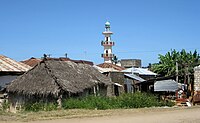Malindi
Bantu-speaking farmers moved into the area, where they smelted iron, built timber and wattle houses thatched with palm leaves, spoke a local dialect of kiSwahili, and engaged in regional and sometimes long-distance trade.
Beginning in the 11th century, the Swahili along the coast were acting as middlemen for Somali, Egyptian, Nubian, Arab, Persian, and Indian traders.
They began building walled towns, coral houses, and elites converted to Islam, often speaking Arabic.
He wrote that Malindi was situated to the south of the mouth of a river which began in a mountain hundreds of miles away.
[5] Once rivalled only by Mombasa for dominance in this part of East Africa, Malindi has traditionally been a port city.
[5] The Portuguese explorer Vasco da Gama met Malindi authorities in 1498 to sign a trade agreement and hire a guide for the voyage to India, when he erected a padrão known today as the Vasco da Gama Pillar.
Like other Mediaeval Swahili towns, the ruling class or wazee was made up of the heads of the wealthiest patrician families.
Similar to other Bantu-speaking peoples, these clan leaders elected a mwenye mui or chief who spoke on behalf of the patricians.
The Portuguese mistakenly titled these individuals "Kings," misunderstanding the nature of Swahili political organisation.
[5] In the years before the arrival of the Portuguese, Malindi was a regional power but lagged significantly behind the two greatest states, Mombasa and Kilwa.
Malindi grew as other Swahili, as well as Arab, Persian, and Indian, merchants, craftsmen, sailors, and labourers flocked to newly powerful city.
An 1823 United Kingdom Admiralty chart of 'Melinda' declared that at that time there were 'no vestiges of the once splendid city of Melinda' apart from Vasco da Gama's Pillar.
Malindi was refounded by Sultan Majid of Zanzibar in 1861 and until the end of 19th century served as a centre of the slave trade.
Outside agriculture there were few industries in Malindi at the beginning of the 20th century; among them were making mats and bags, crushing sesame seeds for oil and producing a Swahili drink called tembo.
During World War II, Malindi was one of only two towns in East Africa bombed by the Italians.
The novels describe the protagonists' (Russian writer Andy and his wife Jennifer, who was born in Kenya) lives in these towns in the 2010s.



